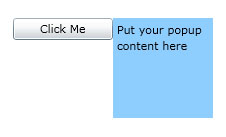
Intersoft ClientUI Documentation
RelativeTo Property

| Intersoft.Client.UI.Controls Namespace > UXPopup Class : RelativeTo Property |
Public Property RelativeTo As FrameworkElement
Dim instance As UXPopup Dim value As FrameworkElement instance.RelativeTo = value value = instance.RelativeTo
public FrameworkElement RelativeTo {get; set;}
public: property FrameworkElement^ RelativeTo { FrameworkElement^ get(); void set ( FrameworkElement^ value); }
By default the bounding box of UXPopup is the control itself, you can customize this by specifying the RelativeTo property. The following code shows how to change the bounding box to another UIElement, in this case its a Button.
| XAML |
Copy Code
|
|---|---|
<Grid x:Name="LayoutRoot"> <Grid VerticalAlignment="Top" HorizontalAlignment="Left"> <Intersoft:UXPopup PreferredPosition="TopRight" x:Name="MyPopup" RelativeTo="{Binding ElementName=MyButton}"> <Grid Width="100" Height="100" Background="#FF8ECEFF"> <TextBlock TextWrapping="Wrap" Text="Put your popup content here" Margin="4"/> </Grid> </Intersoft:UXPopup> </Grid> <Button Width="100" Content="Click Me" x:Name="MyButton" HorizontalAlignment="Center" VerticalAlignment="Center" Click="MyButton_Click"/> </Grid> |
|
| C# |
Copy Code
|
|---|---|
private void Button_Click(object sender, System.Windows.RoutedEventArgs e) { this.MyPopup.IsOpen = !this.MyPopup.IsOpen; } |
|

Target Platforms: Windows 7, Windows Vista SP1 or later, Windows XP SP3, Windows Server 2008 (Server Core not supported), Windows Server 2008 R2 (Server Core supported with SP1 or later), Windows Server 2003 SP2